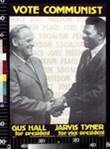 American Communist Party leader, Gus Hall was born Arvo Kustaa Halberg to Matt and Susan Halberg in Cherry, MN a rural community on the Mesabi Iron Range on October 8, 1910.Hall’s parents were Finnish immigrants from the Lapua region; they were involved in the Industrial Workers of the World (IWW) and were early members of the CPUSA in 1919. Hall’s home language was Finnish, and he conversed with his nine siblings in that language for the rest of his life.
American Communist Party leader, Gus Hall was born Arvo Kustaa Halberg to Matt and Susan Halberg in Cherry, MN a rural community on the Mesabi Iron Range on October 8, 1910.Hall’s parents were Finnish immigrants from the Lapua region; they were involved in the Industrial Workers of the World (IWW) and were early members of the CPUSA in 1919. Hall’s home language was Finnish, and he conversed with his nine siblings in that language for the rest of his life.
According to Hall, after his father was banned from working in the mines for joining an IWW strike, the family grew up in near starvation in a log cabin built by Halberg. At 15, to support the ten-child family, Hall left school and went to work in the North Woods lumber camps, mines and railroads. In 1931, Hall to traveled to the Soviet Union and studied for two years at the International Lenin School in Moscow.
 In 1934, Hall was jailed for taking part in the Minneapolis Teamster’s Strike. After serving his sentence, he was blacklisted and unable to find work under his original name. This prompted him to change his name to Gus Hall, derived from Kustaa (Gustav) Halberg.
In 1934, Hall was jailed for taking part in the Minneapolis Teamster’s Strike. After serving his sentence, he was blacklisted and unable to find work under his original name. This prompted him to change his name to Gus Hall, derived from Kustaa (Gustav) Halberg.
Youngstown, Ohio is where Gus met Elizabeth Mary Turner (1909–2003), a woman of Hungarian background. They were married in 1935 until Gus’s death in 2000. Elizabeth was a leader in her own right, among the first women steelworkers and a secretary of SWOC.
Gus ran on the Communist Party USA ticket for Youngstown councilman and also for governor of Ohio, but received little votes. Hall ran for president four times, in 1972, 1976, 1980, and 1984. Both of his running mates were black: Jarvis Tyner, and Angela Davis.

 Gus Hall professed deep confidence in the democratic traditions of the
Gus Hall professed deep confidence in the democratic traditions of the  American people. He remained a prolific writer on currents events, producing a great number of articles and pamphlets, of which many were released in the magazine Political Affairs. Hall also published books for the layman worker, including: The Energy Rip-Off: Cause and Cure (1974); Basics for Peace, Democracy and Social Progress (1980); Fighting Racism (1985); and Working Class USA: The Power and the Movement (1987).
American people. He remained a prolific writer on currents events, producing a great number of articles and pamphlets, of which many were released in the magazine Political Affairs. Hall also published books for the layman worker, including: The Energy Rip-Off: Cause and Cure (1974); Basics for Peace, Democracy and Social Progress (1980); Fighting Racism (1985); and Working Class USA: The Power and the Movement (1987).
The last years of his life Hall lived in Yonkers, NY together with his wife, Elizabeth.They had two children, Arvo (1947–) and Barbara (Conway) (1938–). Along with following political events, Hall’s hobbies included art collecting, organic gardening and painting. In 2000, shortly before his death, Hall resigned the post of party chairman. Gus Hall died on October 13, 2000 at Lenox Hill Hospital in Manhattan from diabetes complications. He was buried in the Forest Home Cemetery near Chicago.